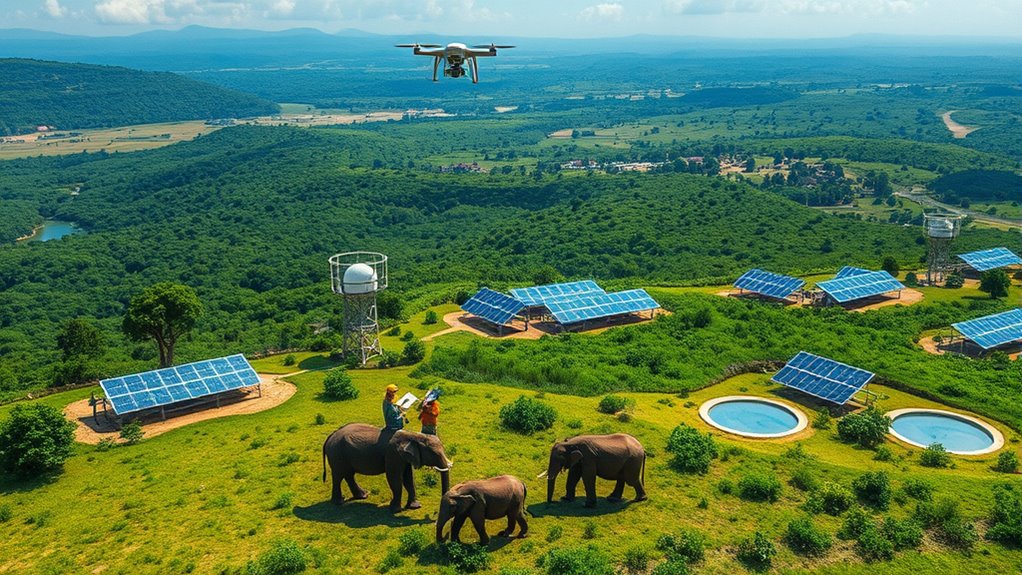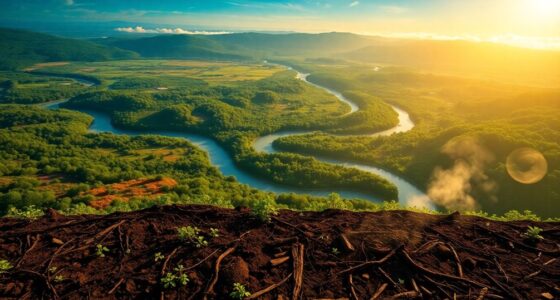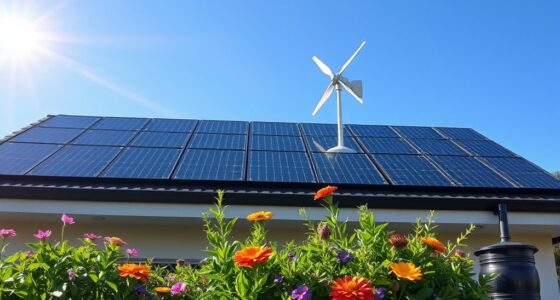In the future, conservation’s getting a major boost from innovations like AI, machine learning, and remote sensing. These technologies help monitor wildlife, assess habitats, and improve decision-making for ecosystem management. Environmental DNA (eDNA) offers non-invasive species tracking, while networked sensors gather real-time data on animal behaviors. Community engagement and bioacoustics further enhance conservation efforts. As these advancements continue to evolve, you’ll discover even more exciting developments that could reshape how we protect our natural world.
Key Takeaways
- AI and machine learning enhance wildlife monitoring by analyzing data rapidly, optimizing conservation strategies, and predicting environmental changes.
- Innovations in eDNA technology allow non-invasive biodiversity monitoring, improving species identification and ecosystem health assessments efficiently.
- Networked sensors and biologgers provide real-time tracking of animal behavior, facilitating better understanding of ecosystems with minimal impact on wildlife.
- Remote sensing and GIS mapping technologies enhance habitat assessments, detecting illegal activities and fostering stakeholder collaboration for effective conservation.
- Community engagement through citizen science and mobile apps empowers public participation, driving awareness and support for conservation initiatives.
The Role of AI and Machine Learning in Conservation
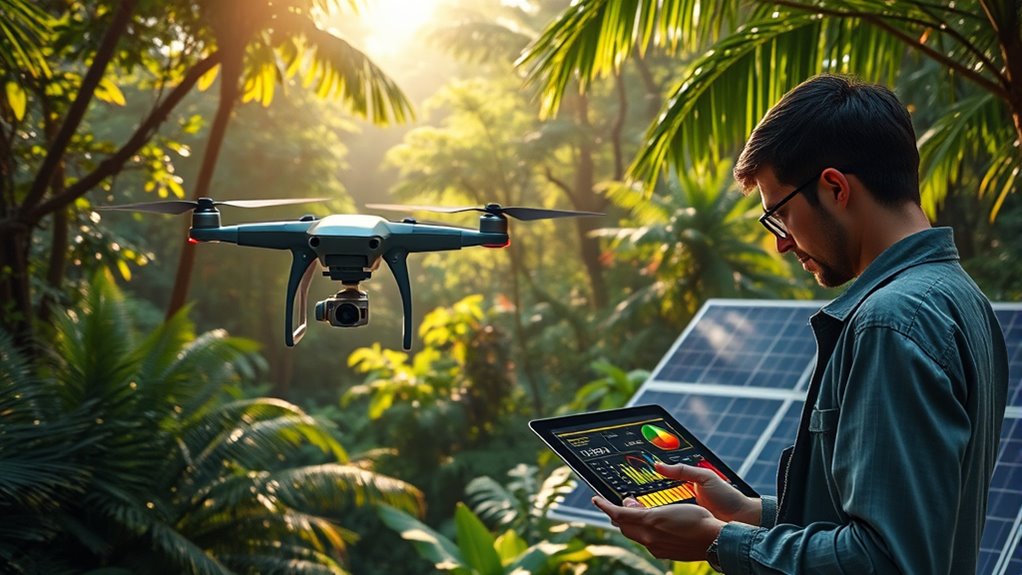
As technology advances, AI and machine learning play an increasingly vital role in conservation efforts. You can leverage AI-equipped cameras and drones to monitor wildlife populations and spot poaching activities effectively. Predictive analytics allows you to forecast environmental changes, while real-time data analysis gives you immediate insights for decision-making. AI simplifies habitat assessment by analyzing ecological indicators, helping you identify areas needing restoration. Moreover, AI plays a crucial role in monitoring wildlife populations, enhancing your strategies. Conservation planning tools suggest optimal locations for protected areas, enhancing your strategies. With machine learning algorithms, you can quickly identify species from vast datasets, reducing analysis time. Additionally, the integration of data analytics helps you optimize resource allocation for conservation projects, improving overall effectiveness. Furthermore, renewable energy innovations can support conservation by powering remote monitoring systems without depleting local resources. The exploration of AI’s transformative role in various fields highlights its potential to revolutionize conservation strategies and improve outcomes.
Advancements in Environmental DNA (eDNA) Technology
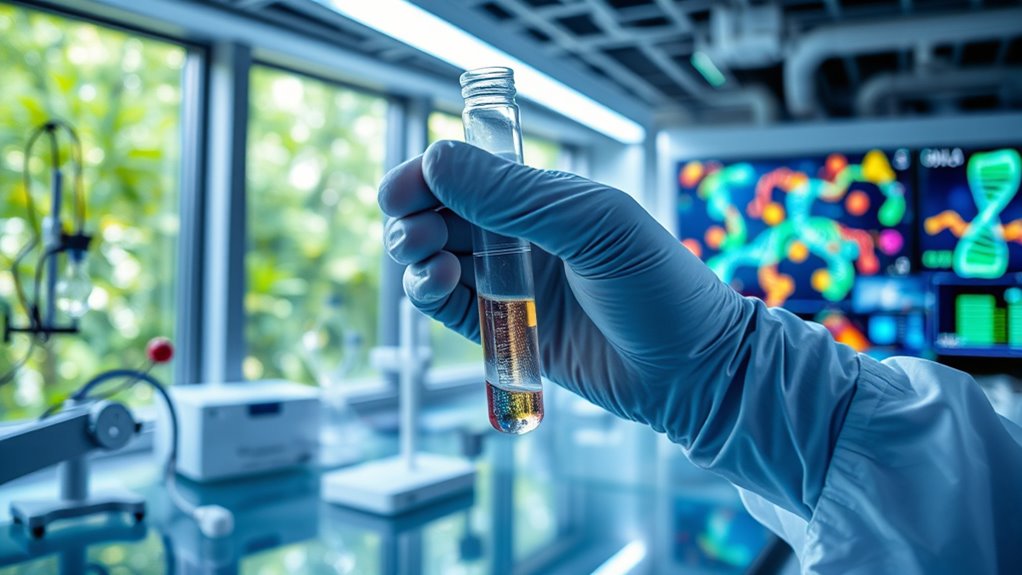
Environmental DNA (eDNA) technology has revolutionized how you can monitor biodiversity, allowing for non-invasive sampling that analyzes genetic material from environmental sources like water and soil. This method detects a wide range of organisms, from animals to microorganisms, in various habitats. Additionally, implementing a robust IRA investment strategy can provide the financial support necessary for advancing such innovative technologies. Renewable energy solutions like heat pumps can also play a crucial role in reducing the environmental impact of traditional monitoring methods, aligning with conservation goals. It is essential to ensure that monitoring practices are sustainable, much like water sources in the wilderness that are crucial for both wildlife and agricultural practices.
It’s often more cost-effective and less labor-intensive than traditional methods. Recent innovations, such as automated samplers and next-generation sequencing, enhance the efficiency and accuracy of eDNA collection, making it scalable to meet global biodiversity targets. Notably, a global levy on products using genetic data from nature has emerged as a significant step in advancing conservation efforts.
eDNA helps identify endangered species, assess ecosystem health, and study climate change impacts. With advanced data analysis tools, you can gain deeper insights into community dynamics and track conservation outcomes, paving the way for more effective environmental management.
The Impact of Networked Sensors on Wildlife Monitoring

Networked sensors have transformed wildlife monitoring by providing a comprehensive and efficient way to track animal behavior and population dynamics.
These Wireless Sensor Networks (WSNs) offer a low-cost solution for monitoring vast areas, integrating various sensors for detailed tracking. You can deploy WSNs in natural reserves or near infrastructures like roads, allowing for innovative applications. Given the potential for tracking and monitoring animals, these systems play a vital role in assessing the impact of environmental changes on wildlife. Additionally, understanding the foraging range of species can enhance the effectiveness of these monitoring systems by providing insights into their behavior and habitat use. For instance, the integration of eco-friendly excursions can promote responsible tourism practices while also contributing to wildlife conservation efforts. Furthermore, the use of sustainable foraging practices can help mitigate human impact on natural habitats while ensuring that wildlife has access to necessary resources.
With real-time data streaming and non-intrusive monitoring, these systems track animal movements without disturbing them. Multi-sensor integration enhances monitoring capabilities, while collaborative functionality ensures efficient data collection.
Innovations in Remote Sensing and Habitat Assessment

While traditional methods of habitat assessment often fell short in accuracy and speed, innovations in remote sensing have revolutionized the field by providing precise, real-time data.
Satellite imagery gives you broad coverage to track land use changes, while drones offer high-resolution images for detailed assessments. LiDAR sensors enhance habitat mapping by capturing topographic details, and multispectral imaging helps monitor vegetation health. Remote sensing detects illegal activities such as logging, mining, or poaching in protected areas, ensuring the protection of vital habitats. Additionally, portable solar panels can power remote sensing equipment, enabling consistent data collection in the field. Furthermore, the integration of high-quality equipment is essential for enhancing the effectiveness of these technologies. By utilizing backyard greenhouses, conservationists can promote sustainable practices while monitoring vegetation health in urban areas.
Satellite imagery and drones provide comprehensive insights, while LiDAR and multispectral imaging revolutionize habitat mapping and vegetation monitoring.
Thermal imaging detects wildfires and monitors wildlife discreetly. With machine learning and AI, analyzing these vast datasets becomes efficient, improving decision-making in conservation.
You can now engage communities through crowdsourcing and ensure transparency with blockchain technology. These advancements not only enhance habitat assessment but also support global conservation efforts effectively.
GIS Mapping: Transforming Conservation Planning

Remote sensing technologies have significantly enhanced habitat assessment, paving the way for GIS mapping to further transform conservation planning. You can use GIS for habitat mapping, resource management, and environmental impact assessments, gaining essential data for your conservation efforts. Its powerful data visualization tools create interactive maps, making complex information easier to understand. By facilitating collaboration among stakeholders, GIS platforms provide a shared space for data analysis and strategy development. You’ll find that GIS increases conservation efficiency by up to 40%, allowing for informed decision-making based on detailed spatial analysis. Moreover, it fosters public engagement through accessible maps, encouraging community participation in conservation initiatives. Embracing GIS mapping truly enhances your conservation planning efforts, as it helps monitor and protect vital habitats from various threats. Additionally, GIS can play a crucial role in identifying biodiversity hotspots, allowing for targeted conservation efforts in areas that need it most. The integration of renewable energy investments into conservation strategies can also enhance the sustainability of these efforts. Furthermore, GIS mapping techniques can be applied to office plants that thrive in various conditions, showcasing how technology can benefit both conservation and urban spaces.
Emerging Trends in Biologgers and Wildlife Tracking
As technology evolves, biologgers and wildlife tracking systems are becoming increasingly sophisticated, offering unprecedented insights into animal behavior and ecology. Miniaturized tags now allow you to study more species with minimal impact. These devices integrate multiple measurements, including location and physiological conditions, while solar power reduces maintenance needs. With satellite connectivity, you can continuously upload data, even from remote areas. The ICARUS system aims to track over 9,000 animals across Europe, providing long-term insights into migration patterns and ecosystem health, contributing to a better understanding of global change drivers. Additionally, the application of due diligence in selecting tracking technologies ensures that researchers choose the most effective tools for their conservation efforts. AI enhances data analysis, enabling you to interpret complex information effectively. Furthermore, the use of high refresh rates in tracking technology can improve the accuracy of real-time data collection, allowing for more precise monitoring of wildlife movements. The integration of energy efficiency audits in conservation technology development ensures that devices are designed with sustainability in mind, minimizing their ecological footprint.
The Significance of Bioacoustics in Conservation Strategies
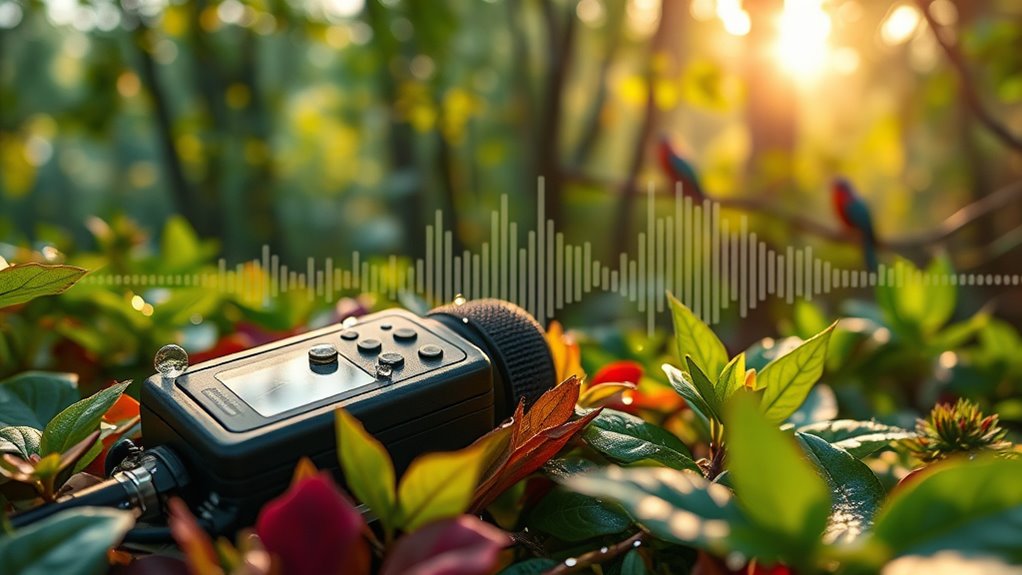
Biologgers and wildlife tracking have opened new pathways for understanding animal behavior, but another innovative approach—bioacoustics—offers a unique lens into the natural world.
By studying sounds produced by living organisms, you gain insights into their behavior, ecology, and biodiversity. Bioacoustics plays a crucial role in conservation, allowing for non-invasive monitoring of ecosystems and species populations. Additionally, acoustic community structure provides valuable information about species distributions and ecological changes over time. Research has shown that foods rich in omega-3 fatty acids can support cognitive function in both humans and animals, highlighting the interconnectedness of health and ecology. Understanding emotional dysregulation can also enhance our approach to conservation by fostering better communication and collaboration among stakeholders. Furthermore, the health benefits of rapeseed honey include antioxidants that help combat oxidative stress, which can be vital for the well-being of both wildlife and ecosystems.
Advanced technologies, like machine learning and cloud computing, enhance data collection and analysis, making it easier to track biodiversity changes over time. You can assess ecosystem health by analyzing acoustic signals, and even detect illegal activities like poaching.
This versatile tool applies to various taxa, from birds to whales, making it essential for effective conservation strategies.
Community Engagement and Collaboration in Conservation Technology
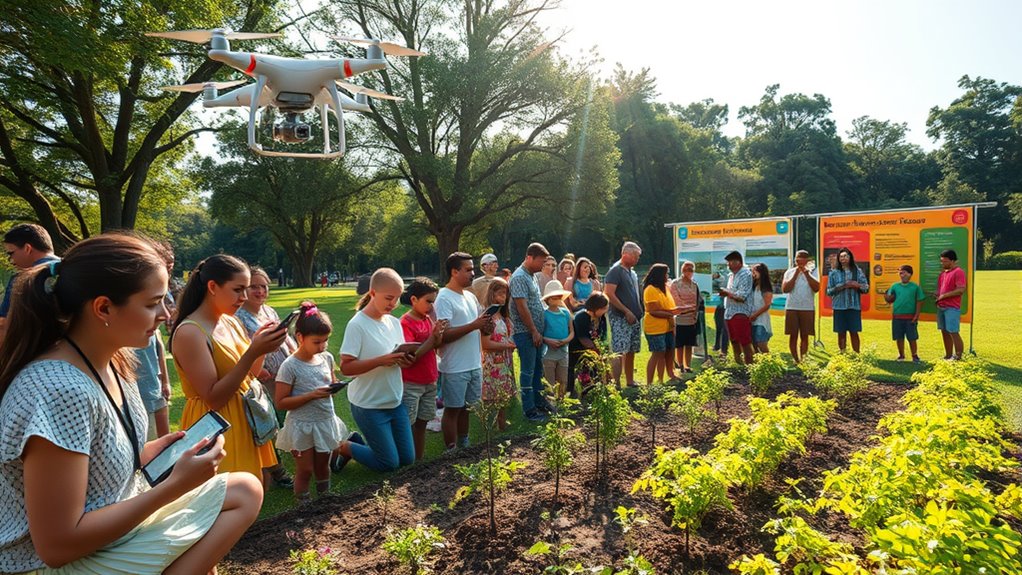
While traditional conservation methods often relied on expert intervention, community engagement has emerged as a vital component in leveraging technology for effective conservation efforts.
Citizen science platforms like iNaturalist and Zooniverse empower you to contribute to scientific research through data collection and analysis. Mobile apps make it easy for you to report wildlife crime, engage in conservation, and share sightings. Biodiversity monitoring tools enable community members to participate actively in tracking species and observing environmental changes. Understanding the importance of composting for soil health can also enhance local conservation efforts through sustainable practices. Utilizing hydrocolloid technology can similarly promote healing in environmental practices by fostering community resilience.
Community-led initiatives enhance decision-making and effectiveness by involving local voices. Collaborative frameworks, like WILDLABS, connect conservationists and technologists, ensuring innovative solutions meet community needs.
Emerging technologies, such as AI and blockchain, foster real-time engagement and transparency. By participating, you help build a sustainable future, ensuring conservation efforts aren’t just expert-driven but community-focused and impactful.
Addressing Challenges and Barriers in Conservation Efforts
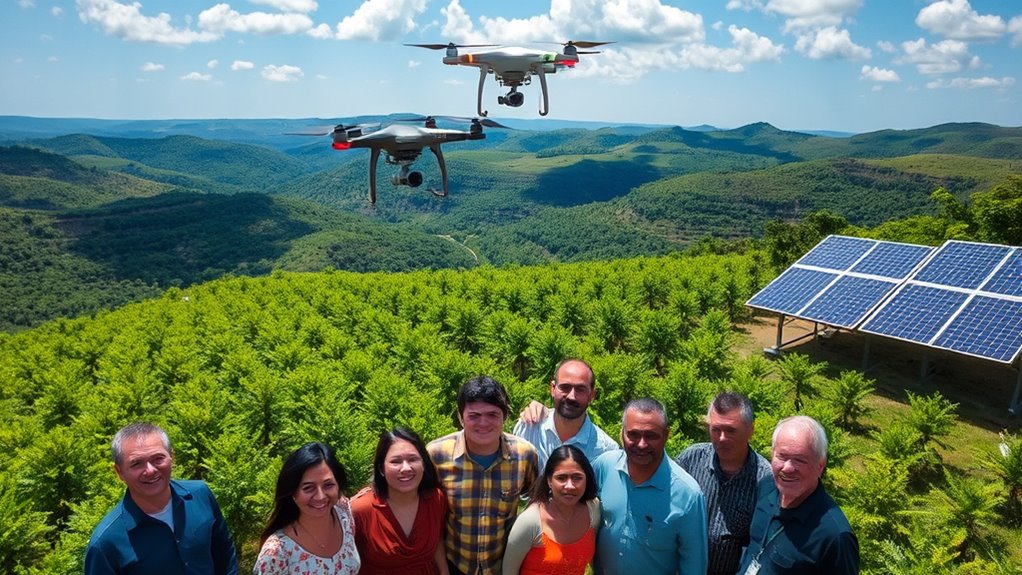
Community engagement has opened new avenues for conservation, but significant challenges and barriers still impede progress. You’ll find that a lack of funding often prioritizes short-term gains over vital long-term goals. Competing economic interests, like agriculture and industry, overshadow conservation efforts. Additionally, the high costs of technology and a shortage of technical expertise limit adoption in your field. Inability to find or retain skilled staff also exacerbates the difficulty of implementing effective conservation strategies. Policy challenges also arise, with conservation ranking low on political agendas, leading to inadequate support. Low public awareness and cultural sensitivities can alienate local communities from conservation initiatives.
Frequently Asked Questions
How Can Individuals Get Involved in Conservation Technology Initiatives?
You can get involved in conservation technology initiatives by seeking out local workshops and training programs.
Participate in hands-on internships to gain practical skills and network with professionals.
Join community groups that focus on integrating technology with local conservation efforts.
Volunteer for projects that utilize drones or AI for monitoring ecosystems.
Don’t hesitate to collaborate with tech enthusiasts and conservationists to create innovative solutions for environmental challenges in your area.
What Are the Career Opportunities in Conservation Technology?
Imagine planting a seed that blossoms into a thriving ecosystem; that’s what a career in conservation technology can feel like.
You’ve got various paths ahead, from becoming an environmental manager ensuring compliance, to a GIS analyst creating digital maps that guide conservation efforts.
As a conservation technician, you’ll measure timber or track wildlife.
Each role plays a crucial part in nurturing our planet, offering fulfilling opportunities to make a real difference.
How Do Funding Constraints Affect Conservation Technology Projects?
Funding constraints significantly impact conservation technology projects.
You’ll notice that limited financial resources restrict project scope and can slow down implementation. Without adequate funding, you risk redundancy in efforts and miss out on innovative solutions.
Moreover, local communities often get excluded due to these financial barriers, which hampers effective collaboration.
To address these challenges, exploring diverse funding sources and innovative models can empower your conservation initiatives and enhance their sustainability.
What Role Do Community Partnerships Play in Conservation Success?
Community partnerships play a crucial role in conservation success. By involving local people, you tap into their knowledge and commitment, which enhances project effectiveness.
When you include communities in decision-making, you address their needs and ensure cultural appropriateness, fostering long-term support. Collaborative efforts often lead to innovative solutions, increased stewardship, and sustainable practices.
Ultimately, these partnerships create a sense of ownership, making conservation initiatives more likely to thrive and achieve lasting impact.
How Is Conservation Technology Evolving in Developing Countries?
Conservation technology is evolving rapidly in developing countries, adapting to local challenges.
You’ll see advancements like AI and networked sensors becoming more accessible, but financial constraints and technical expertise gaps remain significant hurdles.
By fostering interdisciplinary collaborations, you can help create inclusive solutions that integrate local knowledge.
Investing in digital infrastructure and training initiatives will enhance capacity, making these technologies more user-friendly and effective for conservation efforts in your communities.
Conclusion
As we look to the future of conservation, embracing innovations and technologies is crucial, much like planting seeds in fertile soil. By harnessing AI, eDNA, and networked sensors, you can enhance wildlife monitoring and habitat assessment. Collaboration within communities will amplify these efforts, overcoming challenges and barriers. Together, you’re not just preserving nature; you’re nurturing a thriving ecosystem for generations to come, ensuring that both wildlife and humanity can flourish side by side.
